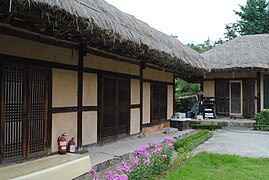Oeam
| Oeam | |
|---|---|
South Chungcheong, South Korea | |
| Nearest city | Asan |
| Coordinates | 36°43′52″N 127°00′49″E / 36.7311°N 127.0136°E |
| Area | 19 ha (47 acres)[1] |
| Designation | 236th Important Folklore Cultural Heritage |
| Designated | January 7, 2000[1] |
| Governing body | Cultural Heritage Administration |
| Website | http://www.oeam.co.kr |
Oeam (
History
The village was founded around the early 16th century by the members of the
Characteristics
In 2011, the village had a population of 192, living in 69 households, out of which 38 households were involved in agricultural activitites. The village preserved its Joseon layout, the buildings reflect the
The village lies at the bottom of the Seolhwasan mountain to the Northeast, and the Bongsusan mountain is to the Southeast of the village. The settlement is of an oval shape, and lies on the imaginary line connecting the two mountains. Houses face South-Southwest. It has one main road, where several side roads join in. Arable land stretches west of the village, and a stream flows between the land and the village. This is a typical Joseon layout for villages. Oeam is special because there are several waterways in the village, connecting the gardens of the houses to the stream. The gardens are characteristic of Korean gardens of the era.[2]
The villagers preserve rituals and customs from the Joseon era that are under national heritage protection, and also prepare food characteristic of the region, such as bukkumi.[2]
-
Local Hanok
-
Garden under the eaves
-
bukkumi
In popular culture
The village served as a shooting location or backdrop to several films and television series, including Taegukgi (2004), Chi-hwa-seon (2002) and Im Kkeokjeong (1996).[3]
References
- ^ a b c d e "Oeam Village, Asan". Cultural Heritage Administration. Retrieved 2021-11-30.
- ^ a b c d e "Oeam Village". UNESCO. Retrieved 2021-11-30.
- ^ "영화속의 외암" (in Korean). 외암. Retrieved 2021-11-30.



